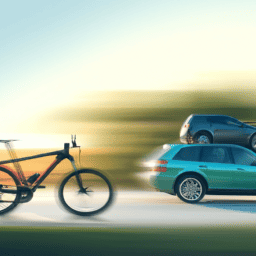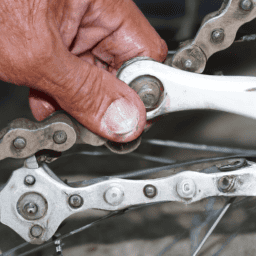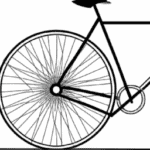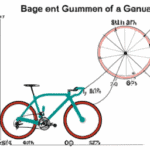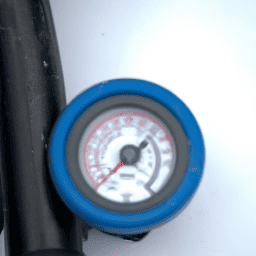Picture yourself on a train station platform, observing two trains moving in opposite directions. To you, it appears as though the trains are traveling at varying velocities, but you understand that in relation to the tracks they are traversing, their speed is the same.
Understanding relative speed is essential in situations like this, where objects are in motion, but their speed is not always what it seems.
In this article, we will explore the concept of relative speed by examining the relationship between a car and a bicycle. We will discuss different scenarios where the car and bicycle are moving in the same or opposite directions, and at different speeds.
We will also look at real-world applications of relative speed, including how it applies to airplanes and boats. By the end of this article, you will have a clear understanding of how relative speed works and how it can be used in practical situations.
Key Takeaways
- Relative motion involves two objects moving relative to each other, and their speeds can be different depending on the frame of reference.
- The relative speed of a car and a bicycle traveling in the same direction is calculated by subtracting the speed of the bicycle from the speed of the car.
- Wind resistance can affect the relative velocity of cars and bicycles.
- Understanding relative speed is essential in various fields such as aviation and maritime navigation and can help in designing safer bike lanes and intersections.
Understanding Relative Speed
Let’s dive into understanding how the speed of a car compares to the speed of a bicycle, shall we?
When we talk about speed, we’re talking about the rate at which an object moves. However, when two objects are moving relative to each other, their speeds can be different depending on the frame of reference we choose to observe them from. This is called relative motion.
To understand relative motion, we need to establish a frame of reference. This is a point of view from which we observe the motion of the objects.
For example, if we’re sitting in a car and another car passes us, we say that the other car is moving faster than us. However, if we were standing on the side of the road, we would say that both cars are moving at different speeds. So, the frame of reference affects how we perceive the motion of the objects.
Moving on to scenario 1: car and bicycle moving in the same direction.
Scenario 1: Car and Bicycle Moving in the Same Direction
When the car and bicycle are traveling in the same direction, they move like two boats sailing side by side in calm waters. To understand the speed of the car relative to the speed of the bicycle, we need to analyze the velocity vectors of both objects.
Let’s assume that the car is moving at a speed of 40 km/h and the bicycle is moving at a speed of 20 km/h. We need to calculate the relative speed of the car with respect to the bicycle. To calculate the relative speed, we need to subtract the speed of the bicycle from the speed of the car. Therefore, the relative speed of the car with respect to the bicycle is 20 km/h. This means that the car is moving 20 km/h faster than the bicycle.
If we assume that the car and bicycle are traveling on the same lane, we can calculate the time of collision between the two objects using their relative speed and the distance between them. However, this scenario is unlikely to happen in real life as the car and bicycle would be traveling at different speeds on different lanes.
Moving on to the next scenario, when the car and bicycle are traveling in opposite directions, we need to consider a different set of variables to determine their relative speed.
Scenario 2: Car and Bicycle Moving in Opposite Directions
You might feel a sense of fear when you see a car and bicycle approaching each other from opposite directions on a narrow road. However, determining the speed of the car relative to the speed of the bicycle is crucial in avoiding collisions. Calculating velocity is the key to understanding this concept.
When the car and bicycle are moving in opposite directions, their velocities are subtracted to find their relative velocity. If the car is traveling at 50 km/h and the bicycle is traveling at 20 km/h in the opposite direction, the relative velocity is 30 km/h (50 km/h – 20 km/h). This means that the car is approaching the bicycle at a speed of 30 km/h. It is important to note that wind resistance can also impact the relative velocity. The faster the objects move, the greater the wind resistance, which can decrease the relative velocity.
This understanding of relative velocity and wind resistance can be useful in avoiding collisions on narrow roads. However, this is not the only scenario to consider. In the next section, we will explore the scenario of a car and bicycle moving at different speeds and directions, which also requires careful calculation of their relative velocities.
Scenario 3: Car and Bicycle Moving at Different Speeds and Directions
It’s important to keep in mind that cars and bicycles can move in different directions and at different rates, which affects their overall movement. When calculating velocity vectors for both the car and bicycle, we must consider their different types of motion.
The car may be moving in a straight line at a constant speed, while the bicycle may be accelerating or decelerating as the rider pedals.
To determine the speed of the car relative to the speed of the bicycle, we must first determine the velocity vectors of each object. We can then subtract the velocity vector of the bicycle from the velocity vector of the car. The resulting vector will give us the relative velocity of the car with respect to the bicycle. This can be helpful in situations where a car is passing a bicycle on the road and we want to know how fast the car is traveling in relation to the bicycle.
Real-world applications of understanding the relative speed between cars and bicycles include designing safer bike lanes and intersections, as well as implementing speed limits for cars on roads where bicycles are present. By understanding the physics of different types of motion and how they affect the relative speed of objects, we can work towards creating a more harmonious environment for both cars and bicycles to share the road.
Real-World Applications
Imagine cruising down a winding road on a bike, feeling the rush of wind in your hair and the freedom of the open road, all while knowing that your safety is being prioritized thanks to the knowledge and application of physics principles in the design of bike lanes and intersections. But the importance of understanding relative speed goes beyond just bike lanes and intersections. In fact, calculating relative speed is crucial in many other fields, such as aviation and maritime navigation.
In aviation, understanding relative speed is vital for calculating airspeed, which is the speed of an aircraft relative to the air through which it is moving. This is important for determining the amount of lift needed to keep the aircraft in the air and for calculating fuel consumption. Similarly, in maritime navigation, understanding relative speed is necessary for calculating the speed of a ship relative to the water in which it is moving. This is important for determining the ship’s position and for avoiding collisions with other vessels. Overall, understanding relative speed plays a crucial role in various fields and is an essential concept to grasp for anyone interested in physics and engineering.
| Field | Importance | Application |
|---|---|---|
| Aviation | Vital | Calculating airspeed, determining fuel consumption |
| Maritime Navigation | Necessary | Calculating ship’s speed relative to water, determining position and avoiding collisions |
| Physics and Engineering | Essential | Understanding relative speed is crucial for various fields |
Frequently Asked Questions
How does the weight of the car and bicycle affect their relative speed?
The weight of the car and bicycle affects their relative speed by influencing the effect of friction and the role of surface area on weight. A heavier vehicle may experience more friction and slower relative speed compared to a lighter one. Surface area also affects weight and speed.
What is the impact of wind resistance on the relative speed of the car and bicycle?
During aerodynamics testing, it was found that wind resistance has a significant impact on the relative speed of a car and bicycle. In fact, wind resistance can reduce the speed of a car by 15% and a bicycle by up to 50%.
Can the speed of the car and bicycle relative to each other change during the scenario?
Relative speed between a car and bicycle can change due to inclines, braking and accelerating on both vehicles. These factors influence the speed of each vehicle and can cause their relative speed to vary.
How does the road condition affect the relative speed of the car and bicycle?
The road surface impact and bicycle tire pressure can affect the relative speed of the car and bicycle. A rough road surface or low tire pressure can decrease the bicycle’s speed, causing the car to appear faster in comparison.
Is the relative speed affected by the distance between the car and bicycle?
The effect of terrain on relative speed is influenced by the distance between the car and bicycle. The cyclist’s skill level can also impact the speed. These factors must be considered when assessing relative speed in a technical and precise manner.
Conclusion
In conclusion, understanding relative speed is crucial in many real-world scenarios. It allows us to calculate the speed of one object in relation to another, which can be helpful in determining the time it takes to reach a destination or avoid collisions.
While it may seem simple at first, relative speed can become complex when dealing with objects moving in different directions and at different speeds. However, with practice and a solid understanding of the concepts involved, anyone can master the calculations.
Overall, the ability to comprehend relative speed is an essential skill for anyone who wants to navigate the world safely and efficiently. Without it, we would be unable to make accurate predictions about the movements of objects around us. It’s truly a superpower in its own right!
